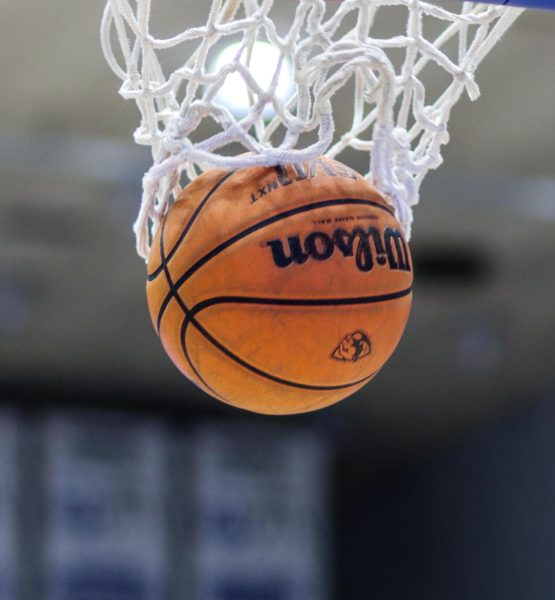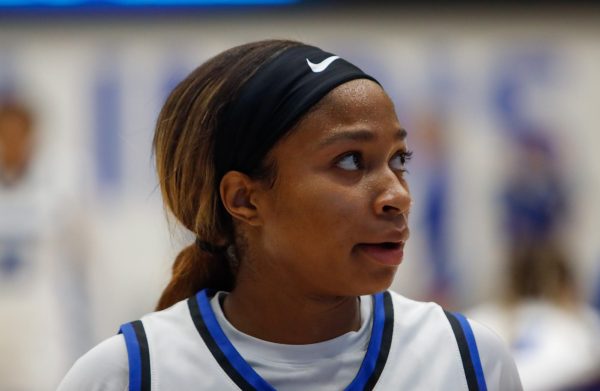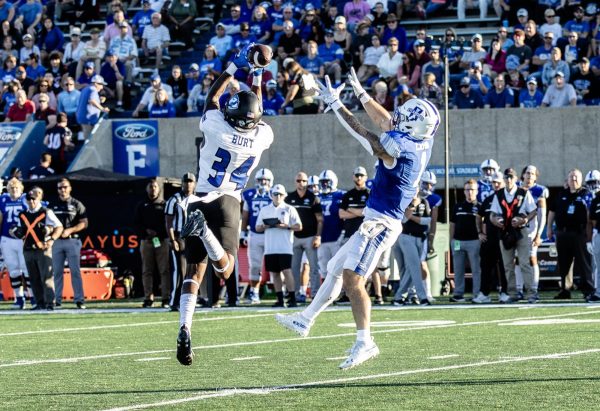Football Bowl Subdivision transfers shape league
The Football Bowl Subdivision transfers in the Ohio Valley Conference could almost form their own team with 61 FBS transfers scattered among the nine league teams.
Eastern defensive coordinator Roc Bellantoni said not only are FBS transfers making the move to the OVC a trend that will continue but it is also helping the league improve. Bellantoni said in past years the Panthers could have overcome some of the injuries they have faced and won games, but that’s not the case this year.
“This year, I think its caught up with us because I think a lot of the teams in our league are better,” Bellantoni said. “If you’re banged up or missing a couple of guys, you can’t get by somebody because the teams are better. I think a big reason why they are better is because of the transfers.”
And the improvement is starting at quarterback. Seven of the nine OVC teams start or have started an FBS transfer under center. In the case of Tennessee State, the Tigers have started two FBS transfers at quarterback and have the possibility of starting a third if necessary.
The transfer quarterbacks are also coming from some of the top conferences in the FBS.
Three are from the Southeastern Conference, and there is one each from the Atlantic Coast Conference, Big East Conference, Mountain West Conference and the Sun Belt.
Two of the quarterbacks are South Carolina transfers (Tennessee State’s Antonio Heffner and Tennessee Martin’s Cade Thompson). The other former SEC quarterback is Jacksonville State’s Ryan Perrilloux (Louisiana State). To round out the list is Eastern Kentucky’s Allan Holland (Wake Forest), Tennessee Tech’s Lee Sweeney (Louisville), Eastern’s Bodie Reeder (Wyoming) and Austin Peay’s T.C. Jennings (Arkansas State).
The influx of these quarterbacks has changed the OVC from more of a power run-oriented league to a league willing to throw the ball more.
And if the teams are still run-oriented, they are a spread offense run team.
“Those guys are athletic guys that can run the ball too,” Bellantoni said about some of the transfer quarterbacks. “While it doesn’t look like they’re running it, a bubble screen is a run play. Everything EKU does is a run play. Just the style of run has changed.”
Bellantoni said the shift from a power run league to more of a spread run league has made it harder to defend against the offenses in the conference because now defenses have to defend the entire field instead of just the middle of the field.
Tennessee State head coach James Webster said this move from power running to the spread offense is happening because the game of football is changing.
The teams that are having more success in the playoffs are the teams that spread the ball around to more players.
“Power football is hard to do,” Webster said. “You’ve got to have more balance. If you’re throwing the football, you can get wide receivers and running backs (involved). You can get more skill players. The quarterback is the driver of the bus, and I think teams are putting more influence on the quarterback.”
Tennessee Martin head coach Jason Simpson said quarterbacks can have the biggest effect on a team, and the FBS transfer quarterbacks in the OVC can do more than just hand the ball off to their running backs or make short completions on screen passes.
“The difference is they can also get underneath center and play action fake and throw out routes and pump routes,” Simpson said. “That’s big boy football. These guys are all confident enough to do a lot of things from a passing standpoint.”
Playmakers now more prevalent in league
The addition of FBS transfer quarterbacks and their ability to make more plays in the passing game has also caused an increase in more wide receivers and running backs making the jump from the FBS level to the Football Championship Subdivision.
“When you’ve got that kind of guy that throws, you’ve got to have good, special people in your wide receivers and running backs,” Austin Peay head coach Rick Christophel said. “All of them now have to catch the football. Your offensive line has to pick up. I think it certainly picks the level up of your surrounding people.”
Christophel, whose team has just two FBS transfers in Jennings and long snapper Nick Newsome (Middle Tennessee State), said he thinks it is easier to bring in those playmaker-type players even though bringing in transfers is not his primary objective.
“If it’s a wide receiver that’s going to be an immediate impact player, (I’ll bring one in),” Christophel said. “You’ve got to have a need for that position when you bring those guys in. You can figure out where to get them the ball and make them a part of the offense.”
Simpson has one of those players in Mike Hicks, a transfer wide receiver from Mississippi.
He said an acquaintance on the Ole Miss coaching staff told him Hicks was looking to leave the Rebels’ program, and then he made his recruiting pitch to Hicks.
“It’s a little different from making a high school recruiting call,” Simpson said. “You’re looking for ‘they’re hungry and they’re looking for another opportunity.’ (Hicks is) probably the first (FBS transfer) I’ve taken that didn’t have any baggage from a disciplinary standpoint that had substantial playing time at an SEC school.”
Bellantoni said Hicks adds one more dimension to the Skyhawks’ already powerful offense that features FBS transfers starting at quarterback, running back and wide receiver.
“When they throw Mike Hicks in there, an Ole Miss, big, physical specimen transfer, that changes the complexion of their offense,” Bellantoni said. “Then you throw in an SEC transfer quarterback. That’s a big-time offense.”
Fitting transfers into an established program
Heffner is by far not the lone FBS transfer on Tennessee State’s roster. In fact, he’s one of 19, which is the most in the conference. But he’s the quarterback that Bellantoni said has been the top signal-caller in the OVC the past three years.
“You could make a pretty penny if you made an Antonio Heffner highlight tape and put it on YouTube,” Bellantoni said. “The guy’s like a human highlight reel. I’ve thought for three years he’s been the premier quarterback in our league because how dangerous he is throwing and running.”
Despite having several FBS transfers at a variety of positions, Webster said he is not inclined to add an FBS transfer to his roster simply because the player is coming from a bigger school.
“The worst thing you can do is bring in a transfer that sits on the bench,” Webster said. “I evaluate our needs.”
Those needs have been on the offensive side of the ball. The Tigers go three-deep with FBS transfer quarterbacks with Dominic Grooms (Missouri) and Jeremy Perry (Middle Tennessee State) backing up Heffner.
But that’s not extent of the Tigers’ offensive prowess from transfer players.
Tennessee State starts two wide receivers that transferred from top FBS conferences. Ronald Evans (Mississippi State) is in his second year with the Tigers, and they added JuJuan Spillman (Louisville) before the start of this season.
“Spillman comes in last minute, and he adds another dimension to their offense,” Bellantoni said. “The guy can really, really run. He was a player at Louisville. He wasn’t a guy that was looking to get more playing time.”
Simpson said Webster has done a good job this season of molding all of his transfers into what was already an established program at Tennessee State.
“I give Coach Webster credit because he’s been able to keep them together, keep them focused and get them to buy into the program and what they’re doing,” Simpson said.
Christophel agreed.
“It’s a testament to Coach Webster to blend and mold these types of personalities into one football team,” Christophel said. “Sometimes you can get too many, and it can backfire on you. You’ve got to know the chemistry of the football team. (The transfers) have got to accept the role you want them to play.”
Webster said he gets more phone calls from FBS transfers released from their previous team than phone calls he makes to actively recruit them. He said the players contact the Tigers’ coaching staff because they know Tennessee State runs a disciplined program and that is something they might need coming from mistakes they made at the FBS level.
“We run a very highly disciplined program,” Webster said. “I’m not going to just sign a guy here because he’s a good player. He’s got to be disciplined and he’s got to be academically inclined and he’s got to be somebody that’s going to work hard. If he doesn’t fit those criteria, we don’t want him.”
A good character player is also something Eastern is looking for when it seeks out FBS transfers.
The Panthers have the second most FBS transfers in the OVC with 11 – four on offense, six on defense and one on special teams.
“They fit in really, really well with the other guys,” Bellantoni said about his defensive FBS transfers. “They haven’t come in with a big head. They knew their role. They just tried to fit in and be a member of the group. There was no tension.”
Bellantoni said Eastern’s coaching staff pursues transfers, for the most part, based on connections with players and coaches at the FBS level instead of random searching for transfers.
He said the Panthers’ coaches aren’t inclined to cold call an FBS school and see if that team has any players leaving.
“We don’t really do that because we want to make sure the kid is a good kid,” Bellantoni said. “If we have players in our program that are familiar with them we know if we’re getting a good kid or a bad kid rather than just recruiting blindly somebody that’s leaving a big program.”
Are transfers a trend that will continue?
Bellantoni said he sees the numbers of FBS transfers in the OVC increasing during the next few years based on players wanting to play immediately and the success they see from FCS players like former Eastern quarterback Tony Romo and former Villanova running back Brian Westbrook.
“Guys want to be successful, and they want to be successful now,” Bellantoni said. “We’re more than happy to provide them the opportunity to get on the field and show what they can do to the scouts and still work toward their degree.”
Simpson had a different outlook on the future of FBS transfers in the OVC. He said transfer quarterbacks, running backs and wide receivers would still make the shift from the FBS to the FCS because they are more likely to get playing time immediately. The transfer numbers from other positions wouldn’t change much.
“Offensive, defensive line, in my opinion, you’re not going to see a lot of those significant players,” Simpson said. “One, those programs don’t want to let those kids go. They want to develop them. Two, the (Academic Progress Report) issues are really going to slow it down. Big schools are like us. They don’t want to lose players because the APR numbers go down.”
The APR is based on a combination of graduation rates, academic success and athlete retention rates.
Webster said he sees the trend of FBS transfers continuing not only in the OVC but also throughout the entire FCS.
“If you look at the teams that are advancing in the playoffs, their marquee players are D-I transfers,” Webster said. “You’re not going to be able to recruit that quality of player out of high school.”
Webster said teams don’t have to have a lot of FBS transfers to be successful. Quality over quantity is more important.
“You can have a lot of transfers, but if they’re not productive you won’t have a very good football team,” Webster said. “You just have to have them at key positions and where they can be productive. When you get those guys at the key positions, you can go out and be successful.”
Scott Richey can be reached at 581-7944 or at srrichey@eiu.edu.
Football Bowl Subdivision transfers shape league

Junior quarterback Bodie Reeder goes for a pass against Murray State Saturday Nov. 1, 2008 at O’Brien Stadium. (Robbie Wroblewski/The Daily Eastern News)
Football Bowl Subdivision transfers shape league

Red-shirt sophomore running back Chevon Walker runs away from a pursuing Austin Peay junior linebacker Daniel Becker on Saturday afternoon at Charleston. Walker transferred to Eastern from Florida and has rushed for 256 yards and two touchdowns on 63 carr





































































